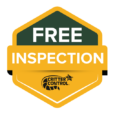Salt Lake City, sandwiched between the southern end of the Great Salt Lake and the snow-capped Wasatch Mountain Range, is the most populous city in Utah. The city and its surroundings have their share of wildlife, ranging from small birds to huge bison. Urban growth, seasonal climate changes and food scarcity, and easy access to human food and shelter are causing more and more wildlife to wander into communities, putting the safety of residents, tourists, pets, and our homes in jeopardy.
Critter Control Wildlife Removal Process
Critter Control is here for you every step of the way in the wildlife removal process. We understand the importance of protecting your loved ones from nuisance wildlife in Salt Lake City, ensuring a safe environment for your family and pets. We also care about wildlife, always handling wildlife humanely and according to all legal and environmental requirements.
We know how to handle any type of nuisance wildlife in Salt Lake City. First, we identify the animal on the property, then use humane methods to trap and remove the pests and then secure weak points where more could enter. If damage has been done, we can make those repairs for a complete restoration.
Pest Control Inspection
During the inspection, we aim to confirm what animal is in your home or on your property, how many there are, where they are located, and how they got in. Based on what you have seen, heard, and smelled, we start the inspection where you noticed signs of animal activity. Evidence of animals inside your home includes nests, dens, feces, and animal tracks. We investigate the exterior of your home, looking for possible entry points, any evidence of animal damage, tracks, fur, animal waste, or rub marks.
Animal Trapping and Pest Removal
We use several methods to humanely remove the animal from your home. Depending on the species, the number of animals, and the condition of your property, we develop a custom wildlife removal plan. Humane wildlife removal strategies include animal traps, one-way doors, and repellents. Once we guarantee that all animals are safely removed, we implement exclusion techniques. Exclusion techniques provide a safe, long-term solution to nuisance wildlife in your home by creating barriers that prevent future infestations.
Exclusion and Remediation
Wildlife damages your home, risks your health, and makes your home feel less like your haven. Our skilled professionals use exclusion techniques to repair any damage the animal causes when getting into your home, as well as the damage they create inside, such as gnawing through beams and wires, defecating and urinating, and spreading parasites such as fleas, ticks, and mites. Ectoparasite treatments exterminate those pests so you don’t become their next host.
Raccoon Removal in Salt Lake City
Raccoons have adapted well to the Salt Lake City urban lifestyle. They prefer making a nest in a cozy place, like your attic, chimney, basement, or garage. They use insulation, papers, carpeting, and any other items they can find. You can hear them growling, squealing, and whining while scavenging.
Raccoons can become aggressive when cornered, especially if they have kits. For your safety, let an experienced Critter Control specialist humanely remove these creatures using the proper equipment. Our process involves:
Salt Lake City and its immediate surroundings are home to a wonderfully diverse amount of wildlife, large and small, including migratory birds, deer, wildcats, bison, rabbits, and yes, rats and mice. Rodents seem to flourish everywhere because of how fast they reach sexual maturity and begin to reproduce. This makes controlling them a challenge. One family of rodents can quickly turn into an infestation.
The cold winter climate makes warm residential homes the perfect environment for seeking food, shelter, and water. The most common rodents trying to cohabitate with you are Norway rats, house mice, white-footed mice, and harvest mice.
Rats and mice gain entry through the tiniest of openings. They can climb anything vertically and jump up to 18 inches. They will gnaw on and chew through wood, window screens, shingles, and siding. Rats burrow in the ground beneath your home, trees, and gardens.
Rat and mouse feces and urine can grow molds that may be dangerous to humans. Let Critter Control do the dirty work of getting rid of all your rodent problems.
Squirrel Removal in Salt Lake City
Salt Lake City, like thousands of cities across the country, is home to many species of squirrels, both native and invasive. They eat garden crops, nuts, fruit, seeds, grains, bark, and leaves. They spend much of their time collecting foods and nesting items for the winter months, which they store in holes that they dig in your yard or your walls or attic.
Squirrels chew through shingles, siding, and screens to get into your home. They will hurry down chimneys, up spouting, and across gutters. Once indoors, squirrels will gather insulation, drywall, and other items to make a cozy den. Some squirrels may build nests in places that can create a fire hazard, like ducts and chimneys.
Other ways squirrels become nuisance wildlife include:
- Chewing on power lines
- Urinating and defecating on your floors and walls
- Destroying trees by stripping bark
- Preventing you from sleeping with their chatter
Bat Removal in Salt Lake City
Utah is home to 18 bat species. Bats are remarkable creatures that are beneficial to our environment because of the insects they eat and the plants they pollinate. Bats can eat a thousand insects in an hour, ridding your property of mosquitoes and other flying pests.
All species of bats are protected in Utah because they are endangered or facing extinction due to diseases. If you have bats living in your attic, barn, shed, or trees, then you have a source of insects for the bats to eat. Stagnant water, manure, fountains, ponds, and pole lights attract insects.
Bats are nocturnal, so while you’re sleeping, they are working. Even if you don’t see bats, you can tell you have a bat problem if you have stains on your buildings caused by bat guano. It can also have an awful smell. Bat guano can grow mold, and if you inhale mold spores, it may cause respiratory problems.
Critter Control experts provide many services to remove and exclude bats, such as installing a bat valve or a one-way door that allows bats to fly out but not re-enter. We also seal all gaps where bats are entering your home and sanitize the areas where they were living. Our specialists are fully trained in how to treat a bat infestation humanely. Because they are federally protected and cannot be harmed, it’s especially important to know when to remove them.
We have two species of skunks in Salt Lake City, the western spotted and the striped, which is the larger of the two. Spotted and striped skunks have different removal laws set by the state. Everyone knows skunks by their spray, which contains sulfur and is ejected from glands near the rectum. Skunks are like all other nuisance wildlife: They are searching for food, water, and shelter.
They raid bird feeders, trash cans, and pet feed. While they don’t climb well, they can dig and will dig to get food. Skunks will eat squirrels, rabbits, moles, eggs, rats, and mice.
The good news is that you won’t likely find a skunk in your attic. The bad news is that you may find one in your crawlspace, basement, garage, and under decks and porches. They also like to hide in any piles of debris, logs, or rocks around your property. They burrow and tunnel under structures and foundations, putting your safety at risk.
If you have a skunk on your property, let Critter Control take the risks that go with getting rid of a skunk.
Few people think of birds as a nuisance. They are beautiful in their diversity of colors and songs. But some species, when they descend in large numbers, can cause extensive damage and create an unhealthy environment.
In Utah, mud swallows like to build mud nests on man-made structures. Pigeons are known for roosting on buildings and for their highly corrosive excrement that damages many surfaces it comes in contact with. European starlings are an invasive species that travel in large flocks. They can damage crops, and their waste not only spreads invasive seeds but can transit disease. House sparrows are also invasive and congregate in flocks to feed on the ground and to roost on buildings.
All of these species create unsanitary conditions when roosting around buildings and produce a loud chatter that is quite annoying. In addition, they harbor parasites such as fleas, lice, and mites.
Chipmunks are part of the squirrel family, although there are some significant differences. Smaller than squirrels, chipmunks primarily live on the ground and in long burrows, whereas squirrels live primarily in trees.
Chipmunk tunnels run about two feet underground and then can continue on parallel to the surface for up to thirty feet. These tunnels can cause structural damage when burrowed under patios, outdoor stairs, foundations, and retaining walls. Around your yard, they eat seedlings and flower bulbs, ruining gardens and flower beds. Since chipmunks don’t hibernate, they will occasionally enter homes in an especially cold winter.
Urban chipmunks have developed a few traits that differentiate them from their rural relatives. They have been documented to have a lower level of curiosity about their surroundings and so are less active and have less interest in grooming. The ready availability of food has left less need for them to explore their environment. What this means for homeowners is that chipmunks in your yard are less likely to leave on their own accord. Their lack of grooming makes it more likely that they are bringing more parasites into your home.


